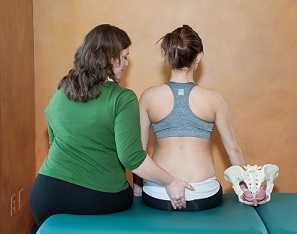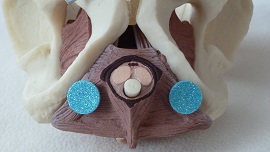
If pelvic floor muscle training (PFMT) is instructed as part of a general exercise class during pregnancy, can this (PFMT) prevent urinary incontinence? A recent post on our site described the systematic review by Bo and colleagues in which the researchers suggested that fitness instructors and coaches should be trained in effective pelvic floor muscle training approaches. A recent article describes such an approach in which a Physical Activity and Sports Sciences graduate instructed in a general exercise class for pregnant women and the class also included PFMT. Nulliparous women completed participation in a pregnancy exercise class (n=63) or a control group (n=89), and in the exercise group, pelvic floor muscle exercises were included. The classes took place 3x/week, for 55-60 minutes each session, for up to 22 weeks, and 8-12 women were in each group class.
Within each exercise class, a typical prenatal program was followed consisting of an 8 minute warm-up, 30 minutes of aerobic training including 10 minutes of strength training, 10 minutes of PFMT and a 7 minute cool-down period. A heart rate monitor and a Borg Rating of Perceived Exertion Scale was used and the women were asked to exercise at a 12-14 on the Borg scale. For pelvic floor muscle training, women were instructed in the anatomy and function of the PFM and in the role of the PFM in urinary incontinence. Although the participants were not formally assessed for correct contractions, the women were instructed in methods of confirming a correct contraction at home such as stopping the flow of urine, self-palpation, or using a mirror to confirm contraction. The PFM exercises started with 1 set of 8 contractions, and the class included both long (6 seconds) and short (1 second) contractions. The participants worked up to a total of 100 exercise contractions that included a combination of short and long contractions, and they were also encouraged to complete the same number of exercises on days outside of class.
Women in the control group received "usual care" including care from a midwife and instruction in pelvic floor muscle health. The outcome tool completed by both groups included the International Consultation on Incontinence Questionnaire- Urinary Incontinence Short Form (ICIQ-UI SF) which was completed prior to and directly following intervention. At the end of the intervention, a significant difference was observed in the women in the exercise group (EG), as 95% of the EG denied leakage, whereas 61% of the control group denied leakage. Of those reporting leakage in the exercise group, the amount of leakage reported was small, and in the control group, amount leaked ranged from small to large. The key points of interest in this study include that first, participation in an exercise group that includes pelvic floor muscle training can prevent urinary incontinence in pregnancy, Secondly, although pelvic muscle function assessment is optimal, participants who did not have PFM contraction confirmed still had positive outcome from the treatment. And because most studies of PFMT are conducted by a physical therapist, this study is unique in its design of having a Physical Activity and Sports Science graduate conduct the intervention.
To learn more about training the pelvic floor, find out which course in the Pelvic Floor Series is right for you. If you have not been trained yet in internal pelvic muscle assessment, the Pelvic Floor Level 1 (PF1) continuing education course is a great place to start. This course fills up many months ahead of time, so check the dates on our website for the best course for you!

The American Heart Association/American Stroke Association Guidelines for Prevention of Stroke in Women reports that although stroke is not common during pregnancy, pregnant women are more at risk for stroke than non-pregnant young women. The guidelines describe the pregnancy-related physiologic factors of venous stasis, lower extremity edema, and blood hypercoagulability as factors in increased risk of stroke. Hypertensive disorders during pregnancy including preeclampsia can also increase maternal and fetal risk, with risk factors of obesity, age over 40, multiple pregnancy, and diabetes.
Postpartum hypertensive issues can also be a concern, and providers should be alert to the symptom of headaches as a potential marker of elevated blood pressure. Although rehabilitation professionals should routinely measure blood pressure in patients, numerous studies have demonstrated that we do not. The referenced guidelines give parameters for blood pressure readings for mild, moderate, and severely high blood pressure readings in pregnancy.
| High Blood Pressure in Pregnancy
|
Diastolic (mm Hg)
|
Systolic (mm Hg) |
| Mild | 90-99 | 140-149 |
| Moderate | 100-109 | 150-159 |
| Severe | ≥110 | ≥160 |
The third trimester and the postpartum period bring the highest risk for stroke, and the authors of the guidelines point out that a stroke can occur with even moderately elevated blood pressure readings. Even if a woman recovers from elevated blood pressure in the peripartum period, she may remain at risk for developing further cardiovascular disease including stroke. Having gestational diabetes, which can later develop into Type 2 diabetes, can also increase stroke risk, meaning that every woman's history related to pregnancy and postpartum cardiovascular health should be taken with interest. Measuring blood pressure regularly is also a habit that therapists must develop.
In addition to screening for elevated blood pressure in the peripartum period, rehabilitation providers can educate women in healthy lifestyle choices, safe exercise activities, and in management of musculoskeletal disorders that may inhibit physical activity. If you are interested in learning more about caring for women in the peripartum period, look ahead at dates for the continuing education course Care of the Pregnant Patient or Care of the Postpartum Patient
Pelvic rehabilitation therapists working with men who have sexual dysfunction may be aware of the work of Grace Dorey, who published a randomized, controlled trial about pelvic muscle strengthening for erectile dysfunction. A recent article published in the Journal of the American Physical Therapy Association confirms the conclusion of Dorey and colleagues that pelvic muscle rehabilitation is beneficial in improving erectile dysfunction.
In the study out of France by Lavosier and colleagues, 122 men with erectile dysfunction and 108 men with premature ejaculation completed twenty 30-minute sessions of pelvic muscle strengthening with active contraction and electrical stimulation. In the study, a penile cuff placed around the shaft of the penis measured intracavernous pressure, electrodes applied to the "upper face of the penis shaft" provided electrostimulation at 80 Hz to the ischiocavernosus muscles, and a vibrator device applied to the glans penis provided stimulation for erection. A large computer screen displayed contractions, and the patient was allowed to increase the level of electrotherapy stimulation to maximal sensory stimulation below pain threshold. Contractions were completed at the patient's own pace in regards to frequency and duration, but each patient did have feedback about his contraction on the computer monitor in front of him. Patients were also given an intracavernosal injection aimed to create an erection lasting 30 minutes.
The authors describe the erection process as being both vascular and muscular, with the ischiocavernosus muscle having a significant role in erections and in ejaculation. The ischiocavernosus muscle, which is a muscle of the superficial layer in the perineum, attaches along the ischiopubic ramus and wraps around the proximal superior portion of the penis to have an effect on penile rigidity. Contractions of the ischiocavernosus appear to maintain the rigidity of the penis through compression of the roots of the corpus cavernosum, the upper portions of the penis where blood fills in the spaces.
This is a very interesting study with equipment and software created specifically for the study. Because ischiocavernosus muscle force could not be directly obtained, force variations were measured using intracavernosal pressure changes during and after pelvic muscle contractions. The authors provide a detailed description of the analysis methods as well as the challenges of measuring the ischiocavernosus muscle with other methods. The lack of uniformity in the contractions and the likelihood that all components (pharmacological, electrotherapy, vibratory stimulation, and feedback) would not be a form of therapy available to all patients in a rehabilitation setting make this study challenging to extrapolate to patient care. However, further evidence that pelvic muscle strengthening can alleviate erectile dysfunction is promising, and the study components also bring into question if patients should be utilizing vibratory therapy, performing home exercise programs for longer periods of time (up to 30 minutes), and if patients should be completing their exercises during states of penile erections. Further research will help us understand the role of each component in pelvic rehabilitation and perhaps to also learn why the results of the study were not as encouraging for premature ejaculation.
To learn more about male sexual health and pelvic floor rehabilitation, you can attend the Male Pelvic Floor Function, Dysfunction, and Treatment continuing education course, with the next opportunity scheduled in Nashville in March.

Incontinence-associated dermatitis causes a range of signs and symptoms, and yet the potential impact of skin breakdown may lead to serious, even life-threatening consequences. Although patients of any functional status or within any treatment setting may be at risk for developing the condition. An article from Beeckman et al. in the British Journal of Nursing describes both the chemical and physical irritation of the skin that occurs when urine or feces remains in contact with the perineal skin. According to this article, urine and feces can cause an increase in the pH levels, and subsequently increase skin permeability, reduce barrier function, and increase the risk of bacterial colonization. Rubbing of the skin on clothing, pads or diapers, or surfaces such as a bed or chair creates friction and can further irritate the skin. The linked article focuses on the differentiation between incontinence-associated dermatitis (AID) and pressure ulcers, and is available for free, full access via the link above if you are interested in learning more about the concept.
If the skin dysfunction is limited to IAD, the pelvic rehabilitation provider may observe rash and erythema with possible skin breakdown, or infections such as candidiasis. Unless a therapist is trained in assessing for pressure ulcers, any new or worsened skin breakdown should be brought to the attention of a physician, nurse, or physician extender who is working with the patient. One of the challenges in perineal skin irritation is that the patient may not be able to easily observe the skin and report new onset or worsening of symptoms. In an outpatient setting, even when working with patients who do not have limited mobility or self-care skills, observing the perineal skin remains critical in documenting skin integrity, persistent issues, or a worsening of a condition. Because, as the authors of this study point out, care for skin ulcers and incontinence-associated dermatitis are different, early recognition and proper diagnosis aids in healing.
Following are some recommendations by Beeckman and colleagues for avoiding skin irritation in the presence of incontinence:
•A perineal cleanser should be used that has a pH range of 5.4-5.9
•Perineal skin should be cleaned quickly following an episode of fecal incontinence, whereas avoiding too-frequent skin washing with continual episodes of urinary incontinence is important
•Moisturizing the skin (with emolient-based rather than humectant-based moisturizer) is valuable in aiding healing and preventing further irritation
•Use a skin protectant to create a barrier between the skin and feces or urine
•Absorptive or containment products (catheter or stool diversion system) can further help keep irritants away from the skin surface
Ideally, issues of incontinence, topics covered at length in the Institute's introductory pelvic floor course series are treatable. Even in the case of refractory incontinence, patients should be made aware of appropriate treatment options and screening by appropriate medical providers can direct patients to proper diagnostic testing and referrals. Because pelvic rehabilitation providers may be the first to notice skin breakdown or risk for infections, recognizing our role in patient education and referral to proper providers remains essential.

From time to time, pelvic rehabilitation therapists ask this question: Does a pelvic rehabilitation therapist really need to "go there?" In other words, is subjective history taking, or perhaps surface electromyography (sEMG) enough of an evaluation and intervention to provide adequate care to patients with pelvic dysfunction? The short answer is no, and here's why: surface EMG is ONE tool for examination and intervention, and one that has limitations. The benefits of using sEMG are numerous: biofeedback has been utilized in much of the pelvic rehabilitation literature, with demonstration of efficacy as an intervention in conditions such as pelvic pain, incontinence, pelvic floor muscle training, and strengthening. Surface EMG, once equipment is acquired, is a relatively inexpensive method for providing feedback, or information about a typically unconscious activity, to the patient. Ideally, the patient internalizes the learned skills based on the biofeedback training and that skill is translated into functional applications such as letting go of a muscle group to avoid tension and pain, or activating a muscle to provide stabilization or protective contractions. So why is biofeedback alone not such a great approach?
Biofeedback does not always provide accurate information about a state of muscle contractility. Consider this fact which was highlighted effectively in Fitzgerald and Kotarinos' 2-part article about the "short pelvic floor": muscles need to produce an electrical event through firing of the motor units (action potential) in order to generate a reading on the biofeedback. When a muscle is in a contracture, or shortening without an active holding of the muscles, surface EMG readings can look "normal" even in the presence of tense, short, symptom-producing pelvic floor muscle states. Unless a therapist is using pressure biofeedback, inaccurate information is then provided to the therapist. Why else would a biofeedback-only approach not provide needed data upon which a pelvic rehabilitation provider bases his or her plan of care? Simply placing external sensors on the perineum or having a patient insert an internal sensor (without therapist observation or placement of the sensor) does not allow for appropriate inspection of the perineal skin, for the presence of prolapse, for the assessment of muscular tension or identification of tissues that are dense, tense, or pain-producing.
If sEMG is utilized in place of perineal observation, internal assessment, or interventions such as therapeutic activity, the therapist misses out on the opportunity to determine muscle tone, muscle tenderness in hard-to-reach places like the obturator internus muscle belly, or the nerve branches near Alcock's canal. It is impossible to know if one side of the pelvic floor is overactive, while the other side is non-functioning due to an old nerve injury or a new onset nerve dysfunction, if the sensors are testing both sides of the pelvic floor simultaneously. And finally, the lack of palpation and proper diagnosis can perpetuate a disconnect for the patient who is potentially relying upon external input rather than tuning in to her own body through the palpation, proprioception, and feedback of muscle states that the therapist can influence by using other evaluation and intervention skills. Consider also the challenge of keeping patients tethered to an sEMG device while trying to perform functional activities such as a golf swing, a lunge, or a jumping maneuver.
In my experience that includes teaching and mentoring of many students and therapists, it has been my observation that when therapists are a bit shy about their internal evaluation skills, sEMG may be relied upon too heavily. External (or internal) sEMG should not be the basis for a pelvic floor muscle training program for every patient. Of course, there are instances when a patient is not a candidate for internal pelvic muscle examination, and sEMG can be a terrific external option. Every patient who presents with indications for, and who does not present with contraindications to a pelvic floor muscle evaluation, should be provided with appropriate internal evaluation and intervention skills, rather than an external-only, sEMG-only approach. A therapist's toolbox should include a multitude of methods with which to approach each patient who presents with pelvic dysfunction.

Can palpation of the coccyx provide an objective screening tool to assess appropriate identification of pelvic floor muscles in patients? Researchers in the UK aimed to determine if external palpation of the coccyx bone would allow an examiner to evaluate pelvic floor muscle activity in women for functions of pelvic muscle contraction or bearing down/straining. Because the pelvic floor muscles, in particular the levator ani muscles, attach to the coccyx via thickened connective tissue, an effective lifting contraction of the pelvic floor muscles should create a flexion movement in a healthy coccyx or tailbone. Likewise, a bearing down may produce an extension movement of the coccyx palpable to a finger placed over the bony landmark.
In this study, 24 healthy women (whom the researchers knew could appropriately contract their pelvic floor muscles) volunteered to participate. The median age of the participants was 57 years old. Results of the study include that the researchers were able to correctly evaluate a contraction, bearing down, or resting position of the coccyx in 56/58 observed.The authors conclude that the coccygeal movement test, or CMT, can be a useful screening test for determining if a woman can appropriately locate and contract the pelvic floor muscles, or PFM. The CMT can be performed in a sitting position or with the subject in a side lying position. In the research study, subjects wore light clothing and were assessed in sitting. The tester placed the middle finger on or close to the coccyx. A correct contraction was considered one in which the coccyx flexed or moved inward. (The participant chose a notecard with the requested action- contract, relax, or neutral- that were shuffled, so that the investigator was blinded to the movement the subject would be completing during the assessment.)
The results of the study indicated that the coccygeal movement test was sensitive (could predict if the woman correctly located her pelvic floor muscles), but not specific (some of the women who could in fact locate the PFM were identified as not being able to locate them.) The authors do not suggest that this external screening test should replace vaginal palpation in women who may require pelvic floor muscle training. Rather, they offer that this simple, non-invasive screening test may provide a method for confirmation of a correct contraction in situations when women are instructed in preventive pelvic floor exercises, such as during prenatal visits. Because many women who are instructed to complete pelvic floor exercises are not offered objective confirmation of appropriate contractions, this test may serve as a middle ground for providers in environments when a quick screen is most appropriate. The authors do caution that the test may misidentify a woman as not being able to properly contract when in fact she is able to contract.
Examination and treatment skills for coccyx are included at length in the course Pelvic Floor Level 2A, in which both external and internal treatment skills are acquired. The next PF2A course is filling up quickly for its scheduled event in Wisconsin in March of next year. The Coccyx Pain: Evaluation & Treatment continuing education course created by faculty member Lila Abbate is back in 2015, a course entirely based on coccyx dysfunction and rehabilitation. The next opportunity to take Lila's course is in California in March.

A recent case report in the Journal of Physical Therapy Science describes the benefits of specific strengthening of the subdivisions of the gluteus medius in a patient with sacroiliac joint pain (SIJ). The intervention is based in prior research that demonstrated varied muscle firing patterns in the gluteus medius during different exercises. The author of the study suggests that the stabilizing role of the gluteus medius can influence sacroiliac joint pain.
The patient in the case report was a 32 year-old female who complained of pain in the left iliac crest area and sacroiliac joints for 6 months. Symptoms worsened with forward bending, standing for more than an hour or walking for more than thirty minutes. Before and after a 3 week intervention of specific strengthening exercises, objective tests included the Gaenslen, Patrick, and the resistive abduction (REAB) test. These tests were all positive for pain provocation. Exercises were instructed for gluteus medius strengthening and were performed over a period of three weeks. Following the 3 week exercise intervention focused on gluteus medius strengthening, the patient's Visual Analog Scale improved from a 7/10 to a 3/10, and repeated objective tests were negative. Exercises for the various portions of the gluteus medius (GM) were prescribed at 3 sets of 30 repetitions/day and are as below:
Keeping in mind that this case represents only one clinician/patient interaction, we can ask ourselves several questions about the positive results of the intervention. Are we currently challenging the hip abductors enough with our patients who have pelvic girdle pain, and is there enough specificity in the exercises to challenge the appropriate muscle fibers? Can isolated strengthening of hip abductors in absence of other interventions have a positive effect on sacroiliac joint pain in our patients? Are there other plausible rehabilitation concepts inherent in performing these open and closed chain activities that contributed to improvement in this particular patient, rather than an isolated increase in muscle training for the gluteus medius? The sacroiliac joint can be a confounding source of pain, and at the same time, successes in treating patients who have SIJ dysfunction can be very rewarding. If you would like to learn more about evaluation and treatment of sacroiliac dysfunction, the next opportunity to take faculty member Peter Philip's course Sacroiliac Joint & Pelvic Ring Dysfunction, offered next in Seattle in January.
According to the World Health Organization (WHO) sexual health relies upon a "…positive and respectful approach to sexuality and sexual relationships, as well as the possibility of having pleasurable and safe sexual experiences, free of coercion, discrimination and violence." This definition provides an excellent framework, yet how many of us were provided with the tools we needed growing up to understand the many domains that affect sexual health such as physical (how does sex work?), and social and psychological implications? Herman & Wallace Pelvic Rehabilitation Institute co-founder Holly Herman has been a long-time proponent of sexual health and function, and in courses, she might be heard asking participants to consider most individuals first sexual encounter: was it relaxed, were both parties informed, was the experience pleasurable? Regardless of a person's stance on when an individual should first engage in sexual activity and with whom, developing a life-long healthful approach to our own sexuality is clearly an integral part of optimizing quality of life.
Ff we expand this concept to the pelvic rehabilitation caseload we often face, how can we best meet the needs of our patients if our own education in sexuality was limited? How can we best understand the varied approaches to sexual health and function if the approaches do not match our own? Our world has fortunately shifted to include the recommendation that healthy sexuality begins in childhood. The American Academy of Pediatrics states that a simple step in childhood sexual development is in using the correct anatomical names for genitalia. How can youth and adolescent sexual health education and support be improved to further promote lifelong healthy sexuality?
An article published last year in the journal Public Health Reports addresses a paradigm shift from teenage pregnancy prevention to youth sexual health. The Oregon Youth Sexual Health Plan was developed in 2009 following a collaborative effort from state agencies and private partners, and focuses on "development of young people" and embracing "sexuality as a natural part of adolescent development." This article lends historical perspective to the advancement of the concept that adolescents have a right to sexual health knowledge, not simply in relation to reproduction and sexually transmitted disease, but also in relation to quality of life and interpersonal relations. The researchers also point out the failure of abstinence-only sex education to produce significant evidence of efficacy.
Goals of the youth sexual health plan include having young people use "accurate information and well-developed skills to make thoughtful choices about relationships and sexual health." Additional goals include that sexual health inequities are removed, rates of teenage pregnancy and sexually transmitted diseases are reduced, and non-consensual sexual behaviors are reduced. The Oregon Youth Sexual Health Plan is public policy, and one that may pave the road for other states seeking to move from a negative stance that focuses on potentially harmful impacts of sexuality to a positive sharing of needed information, knowledge, skills, and support in developing a healthy view of sexuality. If you would like to learn more about sexual health and sexual medicine, join Holly Herman at her course titled Sexual Medicine for Men and Women. The next opportunity to take this course is in January in Houston!
Can pelvic floor muscle training during the peripartum period prevent or cure urinary incontinence? A systematic review was completed by two pioneering pelvic rehabilitation researchers, Kari Bo, and Siv Morkved, physiotherapists who are experts in pelvic floor therapy. The authors included twenty-two randomized, controlled trials (RCTs) or quasi experimental design studies in the field of pelvic floor muscle training during the peripartum period. Interventions included in the eligible studies included exercise and biofeedback, vaginal cones, or electrical stimulation. As is reported among many systematic reviews, the variability among study populations, criteria, and outcomes measures was wide, however, the authors did conclude that pelvic floor muscle training (PFMT) during and after pregnancy can prevent and treat urinary incontinence (UI). This training should be supervised, the contractions instructed should be close to maximum effort, and at least eight weeks duration is recommended based on the review.
Research issues cited as having potential effects on the research reporting include the lack of outcomes data measuring adherence to the instructed exercise programs. Also brought into question is the practice of treating patients with pelvic floor dysfunction once per week, which may effectively provide a suboptimal dose of care if the effect of treatment is to hypertrophy muscles and provide a plan of care based on strength measures. In many studies, the control group was also completing pelvic muscle exercises as part of "usual care" and creating difficulty in assessing differences among treatment and non-treatment groups. Another question posed by the authors is that if physiotherapists, nurses, and physicians are instructing in exercises, is the instruction equivalent based on training? To improve this potential factor, Bo & Morkved suggest that fitness instructors and coaches should be trained in effective PFMT approaches.
The take home point of this study is that PFMT should be a routine part of women's exercise programs,especially during the peripartum period. Bo & Morkved also point out that UI is inhibitory to exercise participation, and should be considered when designing postpartum exercise guidelines. To learn more about postpartum challenges to recovery of pelvic health and function, join faculty member Jenni Gabelsberg in California this winter for the Care of the Postpartum Patient. The next opportunity to take this course is in January in Santa Barbara!
Researchers in Norway aimed to determine if an inpatient rehabilitation program (IRP) was superior to an outpatient rehabilitation program (ORP) in helping women return to work following treatment for breast or gynecological cancers. Being unable to work or having to reduce work capacity due to physical and mental challenges is common after cancer treatment. Accompanying changes in quality of life and health status affect women differently and is often based upon diagnoses, treatment interventions completed, education levels and work status, according to the authors. In this article, women attending separate inpatient and outpatient locations with programs designed to reduce drop-out from work by improving physical, psychological, and social health. 51 women were included in the inpatient program, with 50 in the outpatient program. The variables assessed for outcomes included change in work status, fatigue, and health-related quality of life. At time of admission and 6 months post-admission, women ages 18-67 completed the Fatigue Questionnaire (FQ), the European Organization for the Research and Treatment of Cancer Quality of Life Questionnaire Core 30 (EORTC QLQ-C30), and information about work status.
Interventions for both groups included physical exercise, patient education, and group discussions. Educational and group discussions included topics of cancer treatment and side effects, physical activity, nutrition, work rights and return to work issues, partnership and sexuality, psychological reactions to cancer, and coping strategies. The inpatient program involved 3 weeks of stay during the week, and a 1 week follow-up 8-12 weeks later. Educational training comprised approximately 15% of time, group discussions 25% of the time, and physical activity 60% of the time. Exercise activities included Nordic walking, hiking, spinning, stretching, and relaxation. The outpatient rehabilitation occurred 5 hours/day, 1 day/week for 7 weeks. The lectures in the ORP accounted for 25% of the total time, group discussions 25% of the time, and physical activity the remaining 50% of the time. Because of the significant decrease in time spent in rehabilitation, the authors proposed that the subjects in the inpatient program would experience more significant improvements.
Fortunately, both groups improved significantly, without the expected differences in outcomes between groups. In the inpatient program, 73% of the women improved their work status compared to 76% in the outpatient program. All subjects benefited from either program in health-related quality of life and in fatigue, but no significant differences were noted between groups. One reported difference between the intervention groups is that within the inpatient group, an immediate improvement in fatigue was noted. This improvement was attributed to the 1-2 exercise sessions per day in the IRP. The authors conclude that both inpatient and outpatient rehabilitation programs for women following intervention for breast and gynecological cancers can offer substantial benefit. This conclusion is positive in that some patients may not be able to travel to participate in inpatient programs, and the cost of an outpatient program is significantly less than inpatient programs. To learn more about oncological approaches for rehabilitation, the Institute has several courses available. Susannah Haarmann's Breast Oncology course is taking place in February in Arizona. The Oncology and the Pelvic Floor A course (about the female pelvis) is instructed by Michelle Lyons and is offered next in California in May. Check the website for updates to additional oncology course dates. If you are interested in hosting a course, please contact the Institute, and if you would like to be alerted when a particular course is scheduled in your area, let the Institute know and we can keep you informed of schedule updates!

















































